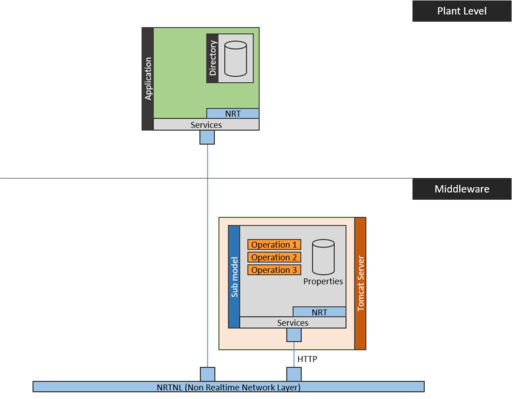Notice: this Wiki will be going read only early in 2024 and edits will no longer be possible. Please see: https://gitlab.eclipse.org/eclipsefdn/helpdesk/-/wikis/Wiki-shutdown-plan for the plan.
BaSyx.Examples.Snippets.AASSMConnection.Java
This code snippet illustrates the connection to an Asset Administration Shell (AAS) sub model using the Java SDK with the ConnectedAssetAdministrationShellManager class. It illustrates the connection to a sub model with a known ID, as well as reading and updating of properties. It also illustrates connection to meta properties.
The BaSys setup for this code snippet is the following:
The BaSys setup consists of a Apache Tomcat server that runs BaSyx Servlets. It contains a sub model provider that exports an example sub model (see here for example). The snippet code runs in context of an application. The application contains the example code and a precompiled BaSyx directory that is used for resolving AAS and sub model IDs to network addresses. The application code accesses the AAS sub model:
// Create manager using the directory stub and the HTTPConnectorProvider ConnectedAssetAdministrationShellManager manager = new ConnectedAssetAdministrationShellManager(registry, // We connect via HTTP new HTTPConnectorProvider()); // Retrieve sub model (created by factory) with SDK connector // - Create and connect SDK connector IIdentifier aasId = new Identifier(IdentifierType.CUSTOM, "aas-001"); IIdentifier smId = new Identifier(IdentifierType.CUSTOM, "sm-001"); ISubModel subModel = manager.retrieveSubModel(aasId, smId); // - Retrieve sub model values and compare to expected values Map<String, ISubmodelElement> smElements = subModel.getSubmodelElements(); IProperty prop1 = (IProperty) smElements.get("prop1"); ISubmodelElementCollection prop2 = (ISubmodelElementCollection) smElements.get("prop2"); IProperty prop11 = (IProperty) prop2.getProperties().get("prop11"); IProperty prop3 = (IProperty) smElements.get("prop3"); assertEquals(smId.getId(), subModel.getIdentification().getId()); assertEquals("smName", subModel.getIdShort()); assertEquals("prop1", prop1.getIdShort()); assertEquals(234, prop1.get()); assertEquals("prop2", prop2.getIdShort()); assertEquals("prop11", prop11.getIdShort()); assertEquals(123, prop11.get()); assertEquals("prop3", prop3.getIdShort()); assertEquals(17, prop3.get());
The code first creates a connected Asset Administration Shell manager that creates connections to Asset Administration Shells and AAS sub models. It uses a ConnectionManager class to create the connection and to resolve AAS and sub model IDs:
// Create manager using the directory stub and the HTTPConnectorProvider ConnectedAssetAdministrationShellManager manager = new ConnectedAssetAdministrationShellManager(registry, // We connect via HTTP new HTTPConnectorProvider());
The following code connects to the sub model with ID "sm-001". It returns a ISubModel instance that provides a local proxy for the remote sub model.
// Retrieve sub model (created by factory) with SDK connector // - Create and connect SDK connector IIdentifier aasId = new Identifier(IdentifierType.CUSTOM, "aas-001"); IIdentifier smId = new Identifier(IdentifierType.CUSTOM, "sm-001"); ISubModel subModel = manager.retrieveSubModel(aasId, smId);
The following code accesses the meta property idShort of the sub model and compares its value to the expected value "sm-001"
// - Retrieve sub model values and compare to expected values assertEquals(smId.getId(), subModel.getIdentification().getId());
The following code accesses the meta property idShort of the sub model property "prop1" and compares its value to the expected value "prop1"
// - Retrieve sub model values and compare to expected values Map<String, ISubmodelElement> smElements = subModel.getSubmodelElements(); IProperty prop1 = (IProperty) smElements.get("prop1"); assertEquals("prop1", prop1.getIdShort());
The following code accesses the values of properties "prop1" and "prop3" of the connected sub model compares their values to expected values.
// - Retrieve sub model values and compare to expected values Map<String, ISubmodelElement> smElements = subModel.getSubmodelElements(); IProperty prop1 = (IProperty) smElements.get("prop1"); IProperty prop3 = (IProperty) smElements.get("prop3"); assertEquals(234, prop1.get()); assertEquals(17, prop3.get());
The following code accesses the idShort meta property of property "prop2", as well as the contained property "prop11". Both requested values are compared to expected values.
ISubmodelElementCollection prop2 = (ISubmodelElementCollection) smElements.get("prop2"); IProperty prop11 = (IProperty) prop2.getProperties().get("prop11"); assertTrue(subModel.getProperties().get("prop2").getId().equals("prop2")); assertEquals(123, prop11.get());
The complete, executable code is available in the basyx.examples project in package org.eclipse.basyx.examples.snippets.aas.submodels.
| BaSyx project links: Project BaSyx main wiki page | What is BaSyx? | BaSyx Developer Documentation |

